Benjamin Moore Salamander (2050-10): Your Ultimate Guide to This Captivating Deep Green Paint Color
Are you searching for a paint color that makes a profound statement without overwhelming your space? A shade that feels both bold and beautifully balanced? You’re not alone. The quest for the perfect deep green can be challenging, as it requires a delicate blend of depth, personality, and versatility. This is precisely where Benjamin Moore Salamander 2050-10 shines, emerging as a designer favorite for its unique ability to transform interiors and exteriors alike.
In this comprehensive guide, we’ll delve into what makes Salamander 2050-10 truly special. We’ll explore its nuanced characteristics, show you how it adapts to different rooms and varying light conditions, and uncover its ideal color pairings and finishes. Moreover, we’ll provide practical advice on how to confidently sample, purchase, and apply this remarkable paint. Get ready to discover if this captivating deep green is the perfect fit to elevate your home’s aesthetic.
Unveiling Benjamin Moore Salamander: A Deep Dive into Its Distinctive Character

If you’re considering a dramatic yet sophisticated hue for your home, Benjamin Moore Salamander 2050-10 is a compelling choice. This isn’t just another dark green; it’s a meticulously crafted shade that brings an unparalleled level of depth and intrigue to any environment. Having witnessed its transformative power in countless spaces, I can attest that it possesses a unique charm that might just be the perfect match for your design vision.
A Chameleon Green Shade with Dynamic Undertones
Salamander 2050-10 is a complex and rich blend, primarily featuring deep green infused with significant black and subtle blue undertones. This sophisticated composition allows the color to dramatically shift and reveal different facets depending on the lighting conditions throughout the day. It’s a color that never truly stays the same, offering a dynamic visual experience from morning to night.
With an exceptionally low Light Reflectance Value (LRV) of approximately 5.72, Salamander absorbs a significant amount of light rather than reflecting it. This characteristic contributes to its moody and enveloping quality, making spaces feel incredibly cozy, intimate, and dramatic all at once. In abundant daylight, the vibrant green tones are more pronounced, offering a sense of connection to nature. However, as the light softens or shifts to artificial sources, the deeper black and blue undertones come to the forefront, lending the color a more mysterious and grounded presence. If you’re seeking a paint that offers a truly immersive and evolving color experience, Salamander delivers this in spades.
The Origins of a Statement Shade: Benjamin Moore’s Color Preview Collection
This distinctive shade finds its home within Benjamin Moore’s esteemed Color Preview Collection, a curated lineup celebrated for its bold, saturated tones designed to imbue spaces with strong character and personality. Salamander fits seamlessly into this collection, standing out as far more than just an average green. It was conceived for individuals who desire a dramatic touch in their decor but prefer it to be sophisticated and understated rather than overly flashy or ostentatious.
The Color Preview group is all about making thoughtful, impactful statements, and Salamander exemplifies this philosophy. It provides significant visual weight and presence while remaining grounded and remarkably versatile. This thoughtful blend of timeless style and inherent strength makes Salamander an ideal choice for anyone looking to profoundly transform a room’s atmosphere, creating a space that feels both luxurious and deeply personal.
Transforming Your Home with Benjamin Moore Salamander: Room-by-Room Inspiration
Having observed Salamander 2050-10 in an array of settings, I can confidently say it possesses incredible adaptability, making it suitable for almost any room in your home. Whether your goal is to cultivate a cozy nook, make a bold design statement, or infuse a space with dramatic elegance, this color offers an impressive range of possibilities.
Living Room: A Grounded and Inviting Sanctuary
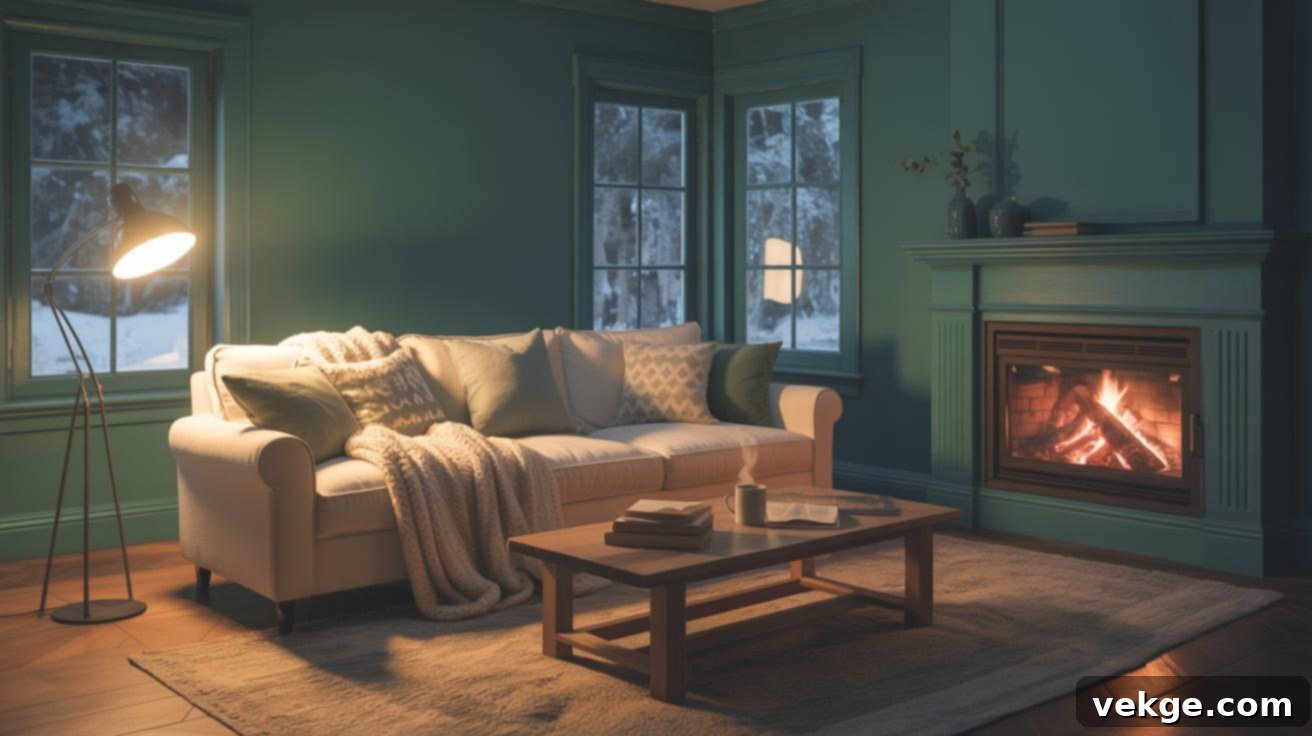
For those aspiring to create a living room that feels both deeply cozy and firmly grounded, Salamander establishes an impeccable foundation. It envelops the space in a rich, deep green that is simultaneously calming and undeniably bold, adding significant character without ever feeling overly loud or distracting. Imagine curling up in a room where the walls themselves contribute to a sense of serenity and sophisticated style.
To achieve a balanced and harmonious look, pair Salamander with thoughtful elements such as warm, diffused lighting, plush, soft textures like velvet or linen, and natural wood accents. This color adapts beautifully to various design aesthetics, from sleek modern to classic traditional or even an eclectic bohemian vibe. If your vision is a living area that exudes an inviting warmth while still making a memorable statement, Salamander will effortlessly help you achieve that sophisticated ambience.
Kitchen Cabinets: Elevating Culinary Spaces with Depth
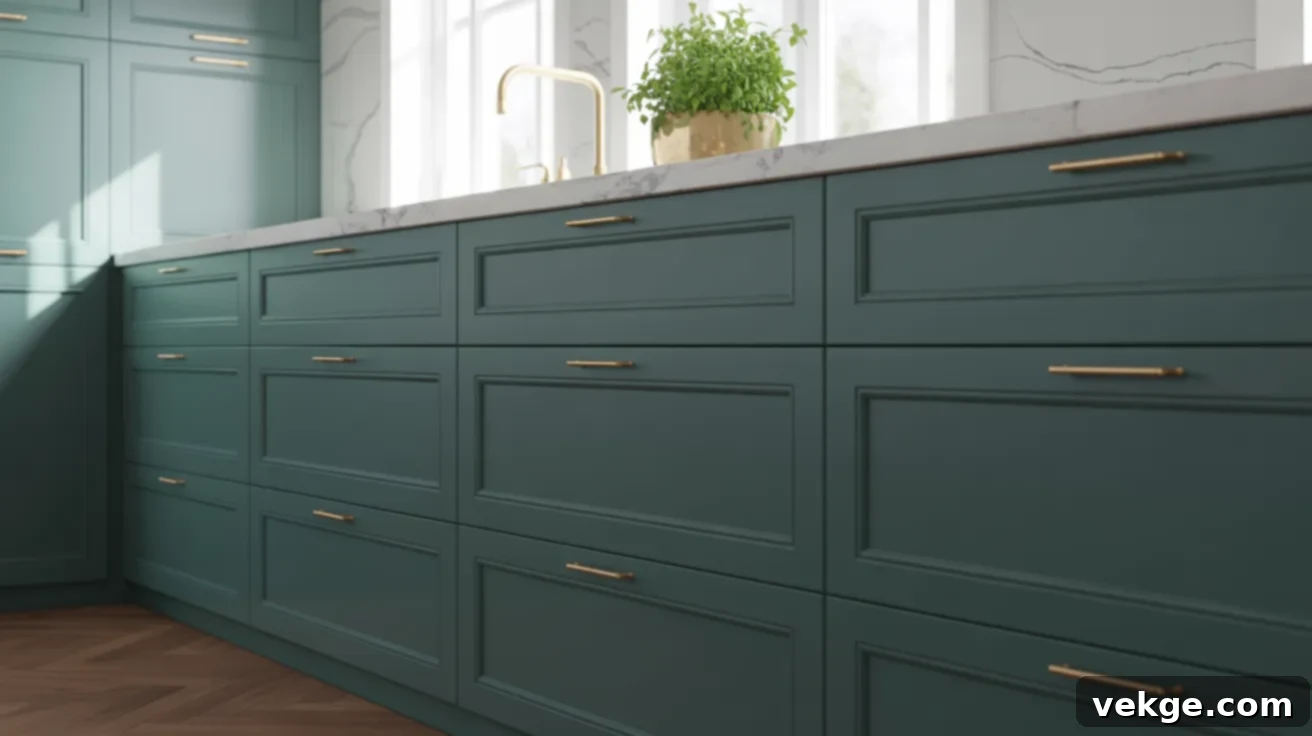
Deep greens like Salamander are increasingly popular in kitchen design, and for good reason—they possess an innate ability to stand out and elevate the entire space. I’ve witnessed how Salamander transforms kitchen cabinets, instantly imparting a rich, custom, and stylish appearance. It adds significant weight and depth, particularly when juxtaposed with complementary hardware finishes such as brushed brass, matte black, or polished nickel, which can truly make the color pop.
You don’t necessarily need a sprawling kitchen for this shade to be effective. Consider using it strategically on a lower cabinet run, a prominent kitchen island, or even an accent pantry door for a subtle yet impactful touch of drama. This sophisticated green is currently trending because it manages to feel incredibly fresh and daring while also retaining a timeless elegance, providing a refreshing alternative to standard whites and grays.
Bathroom Walls: Creating a Spa-like Retreat
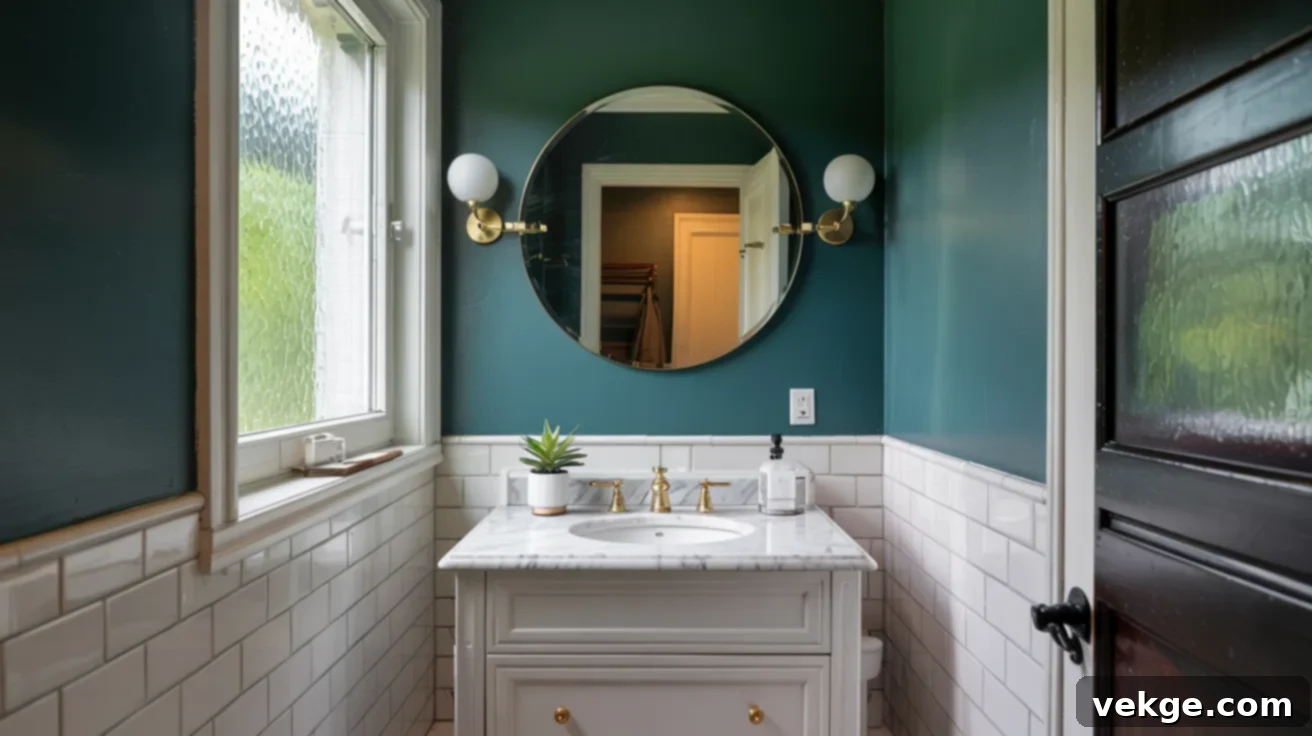
Surprisingly, Salamander proves to be an exceptional choice for bathroom environments. I’ve seen it flawlessly paired with crisp white subway tiles, warm gold fixtures, and natural wood elements to create a balanced, modern, and incredibly serene look. It introduces a deep, grounding tone that beautifully softens the starkness of white without ever overwhelming the smaller dimensions of a bathroom. The result is a moody, sophisticated vibe that maintains a sense of clarity and cleanliness.
Even in compact bathrooms, Salamander adds profound personality and depth without making the space feel closed in, provided there is adequate lighting. Ensure you have good ambient light, perhaps from sconces or a well-placed ceiling fixture, to fully appreciate its nuances. This color can turn a functional bathroom into a luxurious, spa-like retreat.
Bedroom Ambience: A Peaceful and Restful Sanctuary
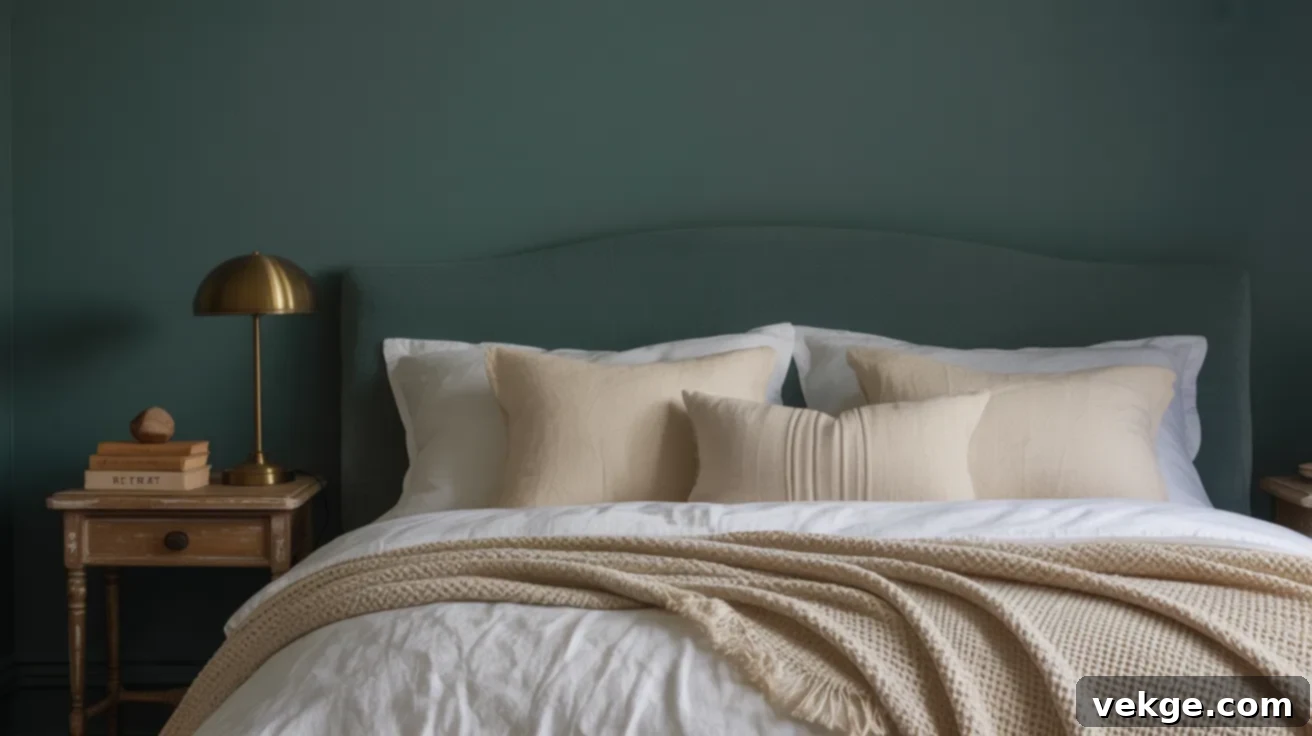
Your bedroom should primarily be a haven of calm and rest, and Benjamin Moore Salamander excels at fostering precisely that atmosphere. This deep green is ideal for bedrooms where the primary objective is to craft a cozy, intimate retreat. It performs wonderfully on a single accent wall, creating a focal point, or can even be applied throughout the entire room for those who embrace darker, more enveloping spaces.
To lighten the overall feel and add textural interest, layer soft bedding in neutral tones—think creamy whites, warm beiges, or natural textures like linen and cotton. You’ll be captivated by how Salamander subtly shifts its character throughout the day, providing your room with just the right degree of moodiness without ever becoming too intense. It creates an environment that feels profoundly peaceful, yet far from plain or uninspired.
Exteriors and Front Doors: Unforgettable Curb Appeal
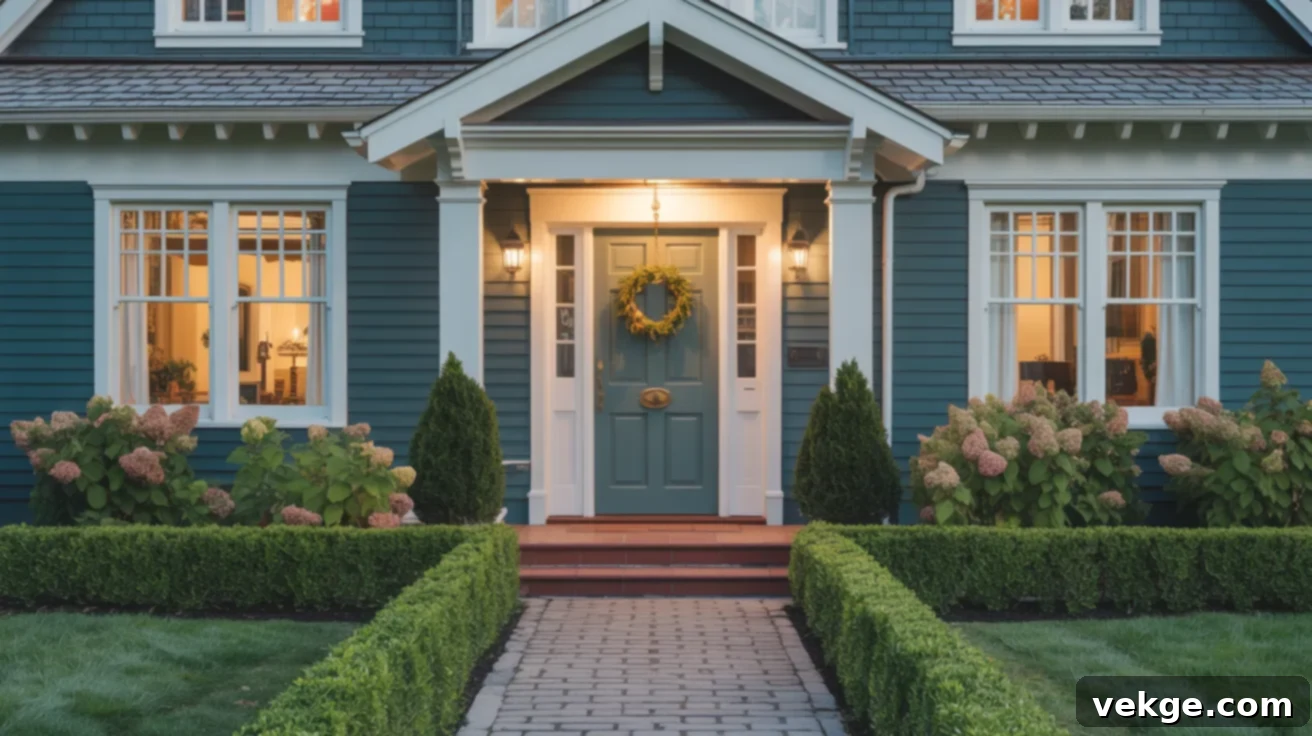
If your aim is to enhance curb appeal with a color that stands out from typical choices, Salamander is an outstanding option. Its robust character holds up beautifully on front doors, siding, or even as an accent on exterior trim. This deep green pairs harmoniously with both light and dark trim colors, instantly making a home look more grounded, sophisticated, and intentionally designed. It commands attention without being ostentatious.
Salamander performs exceptionally well across all seasons, its low LRV ensuring it doesn’t fade into the background. Instead, it maintains a solid, dignified presence outdoors. You can rely on this color to deliver both enduring style and excellent durability against the elements, making your home a true standout in the neighborhood.
Smart Color Pairings and Finishes to Complement Salamander
When I first experimented with pairing Salamander with various colors and finishes, I was struck by its remarkable flexibility. This deep green acts as an anchor, allowing you to build an entire room’s aesthetic around it with just a few thoughtful selections.
Best Neutrals to Match
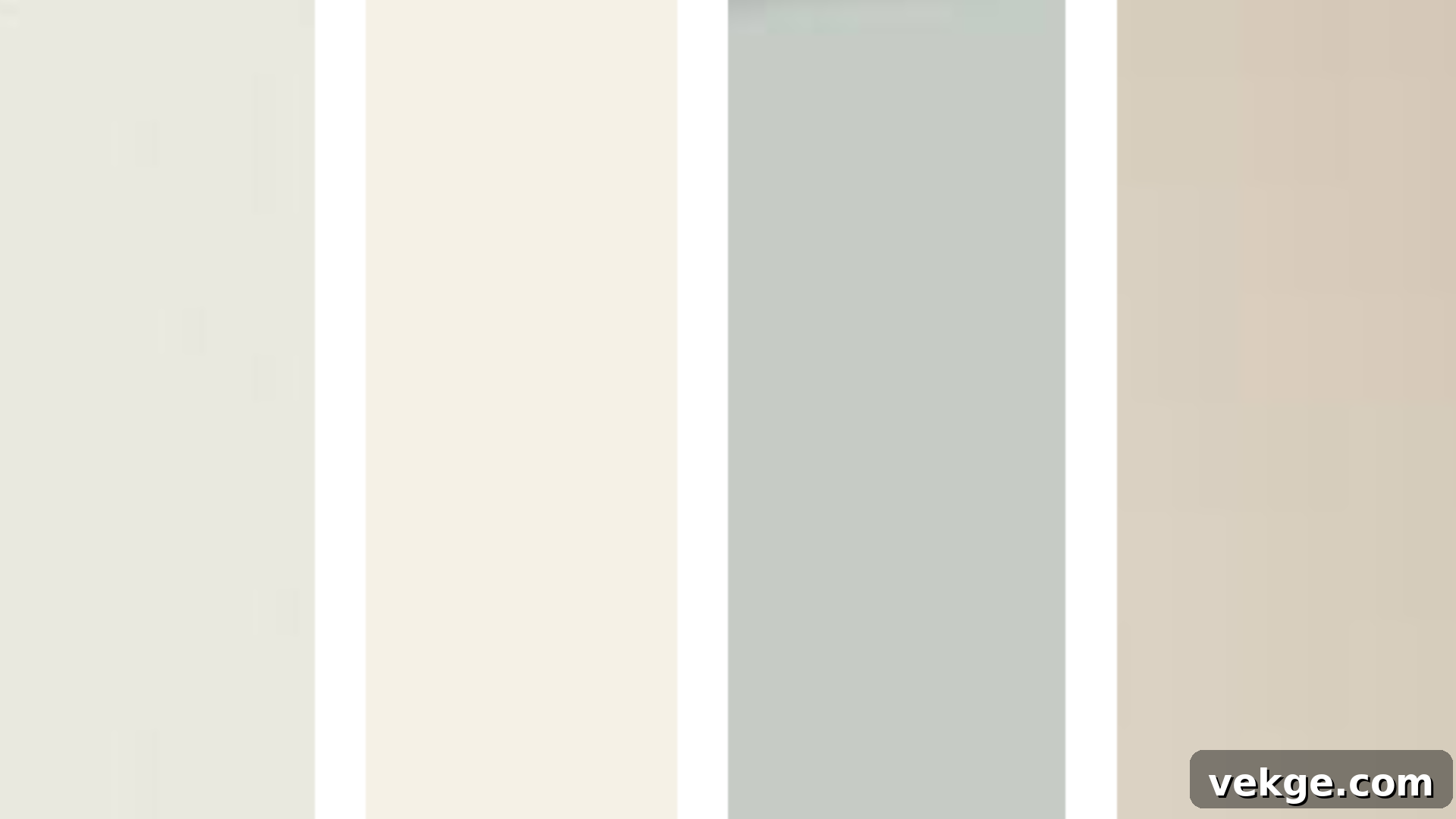
These carefully selected soft neutrals provide the perfect counterpoint to Salamander’s richness, balancing its intensity without ever clashing or competing. They allow Salamander to truly shine while offering visual relief and harmony.
| Neutral Color | Undertone | LRV | Why It Works with Salamander |
|---|---|---|---|
| White Dove (OC-17) | Warm white | 85.38 | A classic, creamy white that adds crispness and softness, preventing Salamander from feeling too dark. Excellent for trim and ceilings. |
| Sebring White (OC-137) | Creamy beige | 80.9 | A slightly warmer, subtle beige that enhances the cozy feel and creates a timeless, inviting combination, especially with natural wood. |
| Silver Marlin (2139-50) | Cool gray-blue | 57.85 | This elegant gray-blue subtly echoes Salamander’s blue undertones, creating a sophisticated and cohesive palette without being overtly vibrant. |
| Edgecomb Gray (HC-173) | Greige | 63.88 | A versatile greige that beautifully blends warmth and neutrality, offering a calm and serene pairing that softens Salamander’s intensity. |
Incorporate any of these neutrals on adjacent walls, trim, ceilings, or through fabric selections for furniture and drapery. They effectively allow Salamander to take center stage, creating a sophisticated and well-balanced aesthetic without overwhelming the space.
Bold Accents to Enhance Depth
To truly bring out the extraordinary depth and complexity within Salamander, introduce thoughtfully chosen rich, bold accents. Consider elements such as lustrous brass lighting fixtures, deep walnut or mahogany furniture pieces, or vibrant splashes of teal, burnt orange, or mustard yellow in artwork or decorative throw pillows. These accents are effective because they offer just enough contrast to stand out, yet their richness complements and supports the luxurious quality of the main green color.
Beyond jewel tones and metallics, you might also explore natural textures like supple leather in cognac or deep brown tones, or even patterned rugs that incorporate geometric or organic designs. With the right bold elements, Salamander transcends mere wall color; it becomes an integral part of a meticulously curated mood, creating a design narrative that is both cohesive and captivating.
Complementary Finishes for Optimal Effect
Selecting the appropriate paint finish is as crucial as choosing the color itself, as it significantly impacts how Salamander appears and performs. You’ll discover that Salamander looks particularly stunning in lower-sheen finishes such as matte, eggshell, and satin.
- Matte: This finish imbues the color with a soft, velvety appearance, enhancing its moody and sophisticated feel. Matte finishes absorb light, which can help to minimize minor wall imperfections and create a very luxurious, understated look. It’s ideal for low-traffic areas like bedrooms or formal dining rooms.
- Eggshell: Offering a subtle, delicate sheen, eggshell provides a bit more durability and washability than matte while maintaining a smooth, refined appearance. This makes it an excellent choice for most living spaces, including living rooms, hallways, and bathrooms, where a balance of style and practicality is desired.
- Satin: For high-traffic areas or surfaces like furniture and cabinetry, a satin finish is often the best pick. It provides greater durability and a slightly higher sheen, giving Salamander just enough polish to feel finished and elegant without being overly glossy or flashy.
Benjamin Moore also offers the Woodluxe stain line for wood applications, providing solid, semi-solid, and ultra-flat options. This versatility ensures that Salamander’s captivating shade can complement both interior and exterior wood projects, creating a cohesive design throughout your property.
How Benjamin Moore Salamander Responds to Different Lighting Conditions
One of Salamander’s most fascinating attributes, which I observed early on, is its incredible responsiveness to light. This color possesses a dynamic personality, shifting gracefully from a soft, earthy green to a profound, moody hue as the day progresses and the lighting changes.
Morning Light: A Fresh and Natural Glow
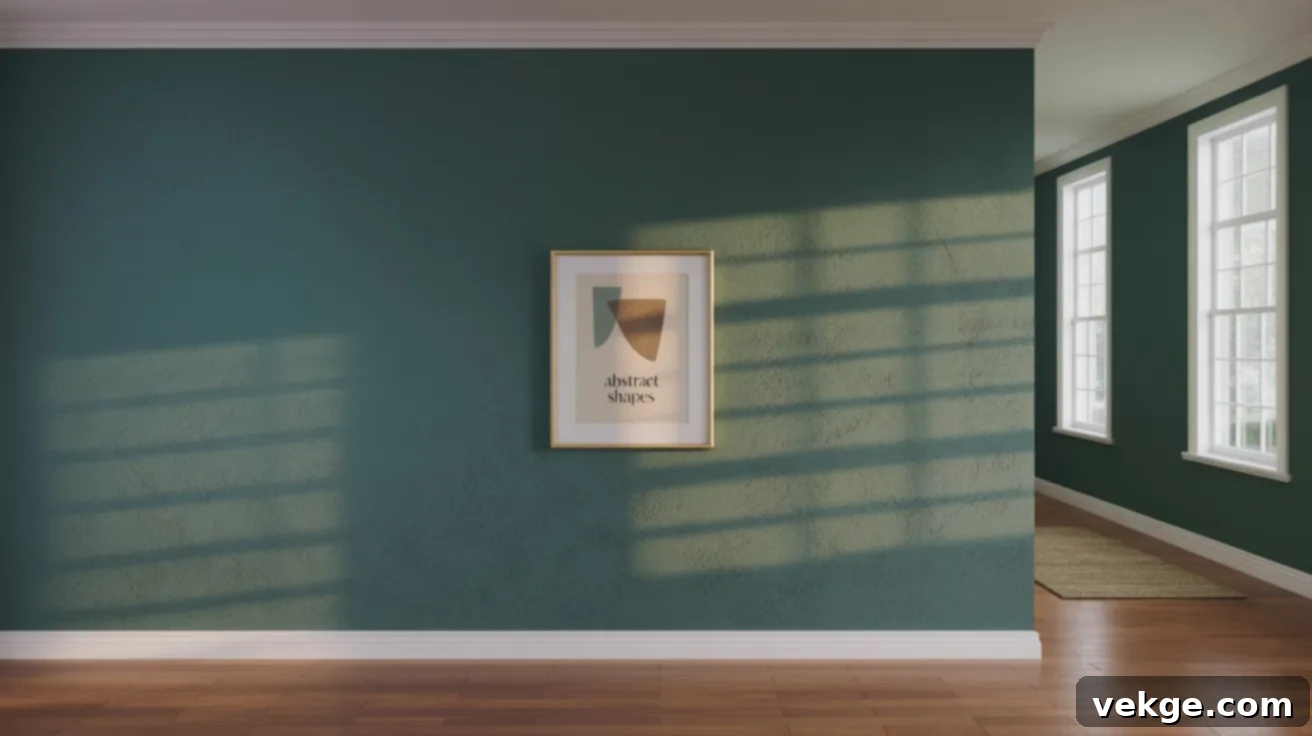
In the gentle embrace of morning light, Benjamin Moore Salamander presents itself with a noticeably greener aspect. The softer, often indirect sunlight, particularly in east-facing rooms, naturally enhances its inherent green hue while subtly toning down the deeper black and blue undertones. This transformation creates a fresher, more balanced, and calming atmosphere, perfectly suited for environments designed for relaxation or gentle awakening. During these hours, the color feels lighter and more connected to nature, evoking the tranquility of a deep forest.
Afternoon Sunlight: Bold and Grounded Intensity

As the day progresses and afternoon sunlight streams in, Salamander truly deepens, emphasizing its inherent boldness and richness. The blue and black undertones become far more prominent, lending Salamander a more dramatic, robust, and profoundly grounded appearance. This is especially true in west-facing rooms, where the direct, intense daylight truly brings out the color’s full depth and complexity. During these peak daylight hours, the shade feels most intense and saturated, making it an excellent choice for a powerful focal point or a feature wall where visual strength is desired. It exudes sophistication and a touch of the dramatic.
Ambient or Artificial Light: Intimate and Luxurious
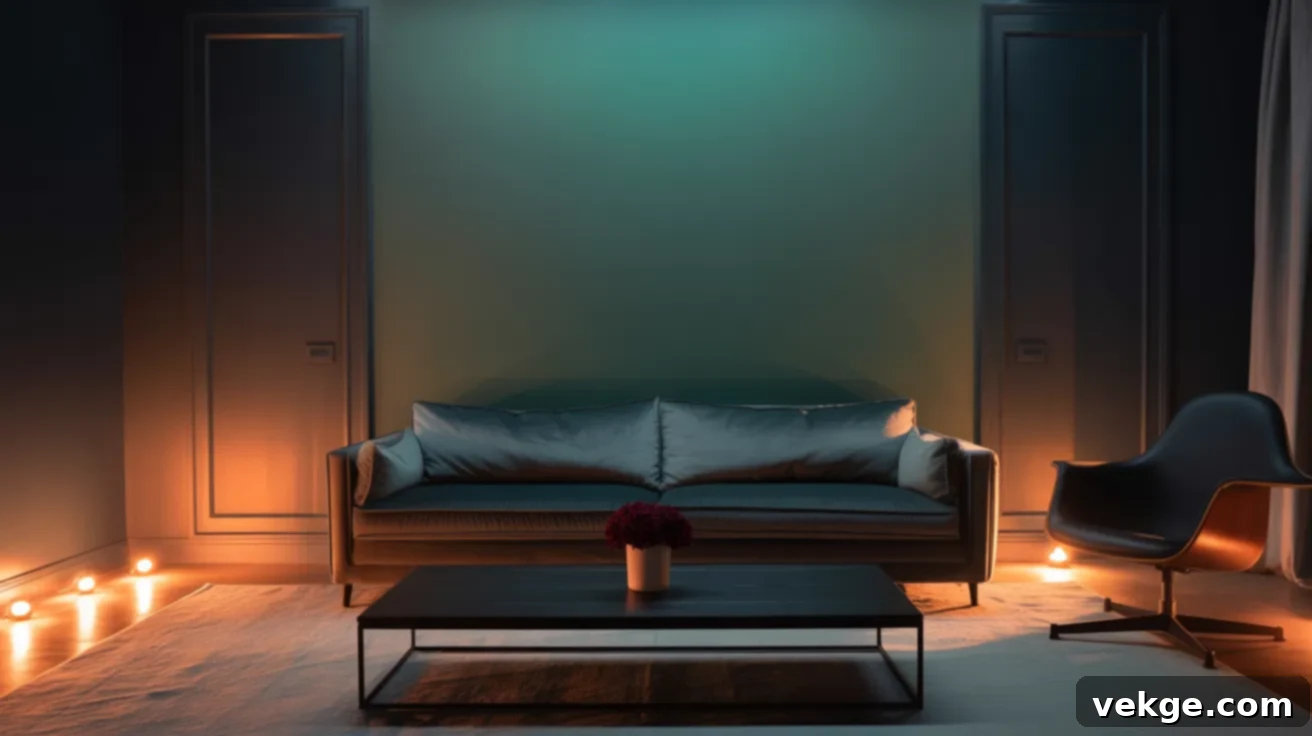
Under ambient or artificial lighting, particularly in the evenings or in rooms with limited natural light, Salamander undergoes another striking transformation. It typically appears darker and more shadowed, with its black elements dominating the tone and the green receding into a more subtle backdrop. The type of artificial light source significantly influences its character: warm-toned bulbs (around 2700K-3000K) will give it a cozier, more inviting appearance, enhancing its snug quality. Conversely, cooler lighting (above 4000K) can make it feel sharper and more formal, highlighting its sophisticated edge.
Its low Light Reflectance Value becomes even more apparent in these conditions, making the shade feel incredibly deep, enveloping, and luxurious. This effect works beautifully in evening settings like dining rooms, media rooms, or bedrooms, creating an intimate and captivating atmosphere.
Simple Steps to Successfully Choose and Apply Benjamin Moore Salamander
Embarking on a painting project, especially with a distinctive color like Salamander, requires careful consideration. The right approach to sampling, selecting finishes, and sourcing your paint can make all the difference between a good color and the perfect one for your space. These simple steps will help ensure a smooth, confident journey to transforming your home.
Peel-and-Stick Testing: The Smart Way to Sample
Gone are the days of messy, small paint swatches and multiple paint cans. Innovative solutions like Samplize offer an incredibly easy and clean way to test Salamander without the hassle. Their high-quality peel-and-stick samples are made with real paint, ensuring accurate color representation, which is crucial for a complex shade like Salamander. These generous-sized sheets can be effortlessly moved from wall to wall and room to room, allowing you to observe how Salamander appears in various lighting conditions throughout the day. This low-commitment, no-fuss option is invaluable for avoiding costly mistakes and building confidence before you invest in a full gallon of paint.
Available Finishes for Every Application
Benjamin Moore Salamander 2050-10 is thoughtfully available in a variety of finishes, each designed to suit different surfaces and desired aesthetic outcomes:
- Matte Finish: Offers a soft, velvety, and non-reflective surface that helps to obscure minor wall imperfections. It creates a rich, sophisticated, and deeply absorbed look, ideal for bedrooms, dining rooms, and other low-traffic areas where a luxurious feel is paramount.
- Eggshell Finish: A very popular choice for walls in most living spaces due to its subtle sheen and excellent durability. It strikes a perfect balance between concealing imperfections and offering easy cleanability, making it suitable for living rooms, hallways, and even bathrooms.
- Satin Finish: Provides a slightly higher sheen than eggshell, giving a smooth, pearl-like appearance. Satin is highly durable and very easy to clean, making it an ideal choice for high-traffic areas, kitchens, bathrooms, trim, doors, and especially cabinetry and furniture, where a gentle luster is desired.
- Semi-Gloss Finish: While not typically recommended for entire walls with dark colors, semi-gloss is perfect for trim, doors, and cabinets where a more pronounced sheen and maximum durability are needed. It highlights architectural details beautifully.
Additionally, for exterior or interior wood projects, Benjamin Moore’s Woodluxe stain line offers solid, semi-solid, and ultra-flat options, ensuring Salamander’s hue can be expertly applied to wooden surfaces while protecting them.
Where to Purchase Benjamin Moore Salamander
Purchasing Benjamin Moore Salamander is straightforward. You can buy it directly from Benjamin Moore’s official website, which also provides digital previews and a convenient local store locator to find a retailer near you. Trusted paint suppliers, such as JC Licht, offer both in-store and online purchasing options, often accompanied by expert guidance from color consultants. For interior design professionals, platforms like Material Bank provide fast, efficient sample-based services. With widespread availability across various paint lines and wood stain options, Benjamin Moore ensures flexible solutions for any design or renovation plan involving Salamander.
Comparing Salamander to Other Popular Dark Greens
While Salamander possesses a unique allure, understanding how it compares to similar popular dark green shades can further refine your decision-making process. Here’s a quick comparison to highlight its distinctive qualities:
|
Paint Color |
Tone & Undertones |
LRV |
Best For |
|
Salamander (2050-10) |
Deep green with significant black and blue undertones, chameleon-like. |
5.72 |
Creating bold, moody interiors, sophisticated kitchen cabinets, and impactful exteriors. Ideal for dynamic light shifts. |
|
Essex Green (HC-188) |
A very dark, traditional forest green with stronger black undertones, less blue. |
4.56 |
Historic and traditional homes, exterior trim, and heritage-style applications where a classic, deep green is desired. |
|
Regent Green (2136-20) |
A rich green with a noticeable gray undertone, giving it a slightly softer, more muted character. |
5.66 |
Subtle accents, refined libraries, and formal rooms where a sophisticated, less intense dark green is preferred. |
|
Black Forest Green (HC-187) |
An extremely dark green, almost black, with deep green undertones only visible in strong light. |
3.07 |
Achieving highly dramatic features, modern minimalist spaces, and exteriors where a near-black green is desired. |
Each of these deep greens offers a distinct mood and level of depth. Your ideal choice will ultimately depend on the specific style, existing elements, and natural lighting of your space, as well as the overall atmosphere you wish to cultivate.
Determining if Benjamin Moore Salamander is Right for Your Space
Choosing a paint color, especially one with such a strong personality as Salamander, requires careful consideration. It’s important to understand that not every color suits every space. Through experience, I’ve learned that the decision to use Salamander largely hinges on factors like room size, the quality and amount of natural light, and the specific mood you’re aiming to create.
When Benjamin Moore Salamander Works Best
Salamander is an exceptional choice for interiors aiming for a bold, high-style aesthetic. It excels on feature walls, in cozy bedrooms designed as luxurious retreats, or in dramatic dining rooms that come alive in the evening. With sufficient natural light streaming into the room, or when strategically paired with lighter, balancing elements, Salamander creates incredible depth and atmosphere without ever feeling overwhelming. It thrives in well-balanced spaces where its richness and contrast can be fully appreciated, especially where existing design elements or architectural features support a darker, more sophisticated palette. It is truly ideal for areas where warmth, intimacy, and a touch of drama are not just welcome but desired.
When to Consider Alternatives or Modifications
Despite its versatility, Salamander might not be the best choice for every scenario. In rooms with very little or no natural light, this deep tone can sometimes make the space feel too heavy or even oppressive, absorbing light rather than bouncing it around. Similarly, in exceptionally compact spaces, the dark hue has the potential to visually shrink the room, making it feel more closed-in than intended. It’s also generally best to avoid using Salamander excessively in areas already furnished with a wealth of dark furniture or finishes, unless a highly monochromatic and intentional design is being pursued. In such cases, opting for a lighter shade on the walls or employing Salamander sparingly as an accent color—perhaps on a single piece of furniture or an architectural detail—might prove to be a more harmonious and successful design strategy.
Essential Tips for Painting with Benjamin Moore Salamander
Working with dark, rich shades like Benjamin Moore Salamander requires a little extra care and attention during application to ensure a flawless and lasting result. Follow these quick tips to achieve smooth, professional-looking walls that truly showcase this magnificent color:
- Prime Properly: Always use a high-quality primer, preferably tinted to a dark gray or the color of Salamander itself. This crucial step helps to prevent uneven absorption, ensures consistent color richness, and often reduces the number of topcoats needed for full coverage.
- Apply Multiple Coats: Due to its deep pigmentation and low LRV, Salamander typically requires at least two, and sometimes three, coats for full, opaque coverage, especially when painting over lighter or bare surfaces. Allow ample drying time between each coat.
- Choose the Right Finish: As discussed, matte or eggshell finishes are generally recommended for walls to control sheen and minimize glare, enhancing Salamander’s sophisticated depth. For trim or cabinets, a satin or semi-gloss finish will provide durability and a subtle luster.
- Utilize Quality Tools: Invest in high-quality painter’s tape for crisp, clean lines along trim and corners. Use fine-bristle brushes for cutting in and a good quality roller (with a nap appropriate for your wall texture) for smooth, even application across larger surfaces.
- Allow Full Drying Time: Patience is key with dark colors. Ensure each coat is completely dry to the touch before applying the next. Rushing the process can lead to streaking, patchiness, or an uneven finish, which is highly noticeable with deep shades.
- Sample Diligently: Before committing to an entire wall or room, use large peel-and-stick samples (like Samplize) or paint sizable swatches directly onto your walls. Observe these samples in various lighting conditions throughout the day to confirm Salamander is the perfect fit for your specific space.
Conclusion: Embrace the Depth of Benjamin Moore Salamander
You’ve now thoroughly explored Benjamin Moore Salamander (2050-10), a truly remarkable deep green paint color. We’ve uncovered its chameleon-like qualities, its sophisticated black and blue undertones, and its impressive versatility across various rooms and architectural styles. From adding a moody elegance to kitchen cabinets to creating a serene retreat in bedrooms or boosting curb appeal on exteriors, Salamander consistently delivers character and depth.
The right preparation, combined with thoughtful color pairings and finish selections, can truly unlock Salamander’s full potential. I sincerely hope this comprehensive guide has equipped you with the knowledge and confidence to consider this bold yet incredibly flexible shade for your own space. Remember, a deep green like Benjamin Moore Salamander doesn’t just fill a wall; it transforms the entire atmosphere and emotional resonance of a room, creating a truly unique and memorable experience.
Ready to discover more inspiring color ideas or practical home improvement tips? Continue exploring our blog to find your next favorite project and elevate your home design journey!
